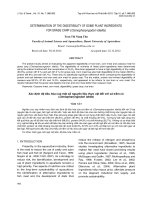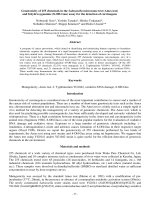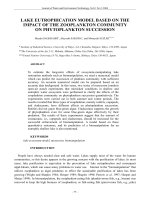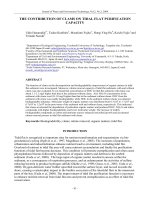the wholeness of nature - bortoft, henri
Bạn đang xem bản rút gọn của tài liệu. Xem và tải ngay bản đầy đủ của tài liệu tại đây (3.55 MB, 1,175 trang )
Renewal in Science
The Renewal in Science series offers books
that seek to enliven and deepen our
understanding of nature and science.
Genetics and the Manipulation of Life:
The Forgotten Factor of Context
by Craig Holdrege
The Marriage of Sense and Thought:
Imaginative Participation in Science
by Stephen Edelglass, Georg Maier, Hans
Gebert & John Davy
Thinking Beyond Darwin:
The Idea of the Type as a Key to Vertebrate
Evolution
by Ernst-Michael Kranich
The Wholeness of Nature:
Goethe's Way toward a Science of
Conscious Participation in Nature
by Henri BortoftCopyright © 1996 by Henri Bortoft
Published in the United States by Lindisfarne
Books
www.lindisfarne.org
Library of Congress Cataloging-in-
Publication Data
Bortoft, Henri, 1938—
The wholeness of nature : Goethe's way
toward a science of conscious participation in
nature / Henri Bortoft.
p. cm.— (Renewal in science)
Includes bibliographical references.
ISBN 0-940262-79-7 (pbk.)
1. Goethe, Johann Wolfgang von, 1749—
1832—Knowledge—Natural history. 2.
Goethe, Johann Wolfgang von, 1749—1832
—Knowledge—Science. 3. Nature in
literature. 4. Nature (Aesthetics) 5. Science in
literature. I. Title. II. Series.
PT2213.B67 1996
831'.6—dc20
96-9358
CIP
An earlier version of part I of this work,
“Authentic and Counterfeit Wholes,” was first
published in Systematics, vol 9, no. 2 (1971),
and a thoroughly reworked version was
subsequently published in Dwelling Place and
Environment (edited by Seamon and
Mugerauer) by Martinus Nijhof, 1985.
Part II of this work, “Goethe's Scientific
Consciousness,” first appeared as Institute for
Cultural Research Monograph no. 22,
published by The Institute for Cultural
Research, 1986. They are printed here by
permission.
Cover art: Sketch by Goethe, Weinreben
(Grapevine), probably August, 1828.
Reproduced by courtesy of Goethe—und—
Schiller Archiv, Weimar, Germany. Photograph
by Sigrid Geske.
Cover design: Barbara Richey
Typography & interior design: Watersign
Resources
All rights reserved.
No part of this book may be reproduced in any
form without the written permission of the
publisher, except for brief quotations embodied
in critical reviews and articles.
To the memory of
DAVID BOHM
who introduced me to the problem of
wholeness
Contents
Preface
I. Authentic and Counterfeit Wholes
INTRODUCTION
TWO EXAMPLES OF WHOLENESS:
HOLOGRAMS AND THE UNIVERSE OF LIGHT
AND MATTER
THE HERMENEUTIC CIRCLE
THE WHOLE AND THE PARTS
ENCOUNTERING THE WHOLE: THE ACTIVE
ABSENCE
WHOLENESS IN SCIENCE
GOETHE'S WAY OF SCIENCE
THE UR-PHENOMENON
CONCLUSION
II. Goethe's Scientific Consciousness
1. Introduction
2. Making the Phenomenon Visible
NEWTON'S EXPERIMENTS
THE PRIMAL PHENOMENON OF COLOR
GOETHE'S SCIENTIFIC CONSCIOUSNESS
Knowing the World
Unity without Unification
Modes of Consciousness
The Depth of the Phenomenon
3. Goethe's Organic Vision
THE UNITY OF THE PLANT
The One and the Many
THE UNITY OF ANIMAL ORGANIZATION
The Necessary Connection
4. The Scientist's Knowledge
III. Understanding Goethe's Way of Science
1. Introduction
2. The Organizing Idea in Cognitive
Perception
3. The Organizing Idea in Scientific
Knowledge
THE ORGANIZING IDEA IN OBSERVATIONAL
DISCOVERIES
THE ORGANIZING IDEA IN THE THEORIES OF
SCIENCE
Copernicus and the Moving Earth
Galileo and the Moving Earth
The Idea of Inertial Motion
THE ORGANIZING IDEA OF MODERN
SCIENCE
The Quantitative Way of Seeing
The Metaphysical Separation
4. Understanding the Science of Color
NEWTON AND THE MATHEMATICAL
PHYSICS OF COLOR
THE PHYSICS OF GOETHEAN STYLE
5. The Goethean One
MODES OF UNITY
SEEING THE DYNAMICAL UNITY OF THE
PLANT
The Unity of the Plant Kingdom
The Unity of the Organism
6. Seeing Comprehensively
THE TWOFOLD
7. The Possibility of a New Science of
Nature
NOTES
BIBLIOGRAPHY
ABOUT THE AUTHOR
Preface
Why would anyone in the 1990s write a book
on Goethe's way of science? Perhaps because
of a scholarly interest—wanting to find out the
truth about Goethe's scientific ideas, to discover
what he had in mind. No doubt this would be a
valid reason, but it is not mine. To begin with I
don't speak German, so writing a scholarly
book on Goethe would be, for me, equivalent to
trying to climb a mountain without first having
learned to walk. But what other reason could
there be for writing about the scientific work of
someone who died in 1832, especially when his
ideas were rejected by the scientific
establishment as the work of a muddled
dilettante? The widespread judgment of
Goethe's science seems to be just that: Great
poet and dramatist he might have been, but he
didn't know what he was talking about when it
came to science. But times have changed since
Goethe's day. Modern science had barely begun
then, whereas now it has matured and we have
had a chance to see its implications and
consequences more clearly. Equally important,
we now understand science better—the
revolution in the history and philosophy of
science is responsible for that.
My interest in Goethe arose as a result of
working as a postgraduate research student
under David Bohm on the problem of wholeness
in the quantum theory, back in the 1960s. To
those of us who had the privilege to participate
in his daily discussions, Bohm communicated a
sense of the way that wholeness is very different
from how we have become accustomed to
thinking of it in modern science. When I first
came across Goethe's scientific ideas, I
immediately recognized in them the same kind of
understanding of wholeness that I had
encountered with Bohm. But from the beginning
I saw Goethe's way of science in practical
terms, as something that was “do-able”—even
though my own interest was, and is, largely
philosophical. Because I had been taught
exercises in seeing and visualization by J.G.
Bennett in the 1960s, I was able to recognize
what Goethe was doing instead of being limited
to only what he was saying. So, thanks to this, I
was not restricted to an intellectual approach.
Working with Goethe's practical indications
brought me to an understanding of Goethe's way
of science which was not only more lively than,
but also somewhat different from, what I could
read in standard academic accounts. For
example, by practicing Goethe's method of
seeing and visualizing with plants, I came to
experience the way that this turned the one and
the many inside out. I later found that, using the
same means, I could share this perception with
students, and that we could begin to understand
the whole and the part, the one and the many,
the universal and the particular, in a radically
new way. I would not have experienced this
transformation in the mode of cognition for
myself if I had done no more than read Goethe
intellectually. What can only seem abstract to
the intellectual mind becomes living experience
when Goethe's practice of seeing and visualizing
is followed. Doing this gives us a sense of a
different kind of dimension in nature. It is no
exaggeration to say that it turns our habitual way
of thinking inside out, and I have tried to write
this book in a way that will give readers a taste
of this for themselves.
Over the past few decades, we have become
increasingly aware of the importance of the
cultural context within which modern science has
developed. The new field of history and
philosophy of science has shown us what is
referred to now as the historicity of scientific
knowledge, the way that cultural-historical
factors enter into the very form which scientific
knowledge takes. We have, for the most part,
given up thinking of science as an autonomous
activity which stands outside of history, or
indeed outside of any human social context,
pursuing its own absolute, contextless way of
acquiring pure knowledge. In fact, now we have
begun to recognize that this view of science itself
first arose within a particular cultural-historical
context, and that it is an expression of a style of
thinking which has its own validity but does not
have access to “ultimate reality.” We can now
recognize, for example, that the fact that modern
physics is true—which it certainly is—does not
mean that it is fundamental. Hence it cannot be a
foundation upon which everything else, human
beings included, depends. Recognizing that the
foundations of science are cultural-historical
does not affect the truth of science, but it does
put a different perspective on the fundamentalist
claims made on behalf of science by some of its
self-appointed missionaries today. Looked at in
the light of the new discoveries in the history and
philosophy of science, such claims to have found
the ultimate basis of reality look like no more
than quaint relics from a bygone age.
It is astonishing to realize just how modern
Goethe was in this respect. Almost two hundred
years ago, he discovered the historicity of
science for himself, expressing it succinctly when
he said, “We might venture the statement that
the history of science is science itself.” He came
to this understanding as a result of his struggle
with the science which had fundamentalist
pretensions in his own day, i.e., the science of
Newton. This understanding makes Goethe our
contemporary. We realize now that nature can
manifest in more than one way, without needing
to argue that one way is more fundamental than
another. So there is the possibility that there
could be a different science of nature, not
contradictory but complementary to mainstream
science. Both can be true, not because truth is
relative, but because they reveal nature in
different ways. Thus, whereas mainstream
science enables us to discover the causal order
in nature, Goethe's way of science enables us to
discover the wholeness. I suggest that this
science of the wholeness of nature is a vision
much needed today in view of the limitations in
the perspective of mainstream science which
have now become so evident.
The three essays which appear here were
written at different times and under different
circumstances. “Authentic and Counterfeit
Wholes” first appeared as “Counterfeit and
Authentic Wholes: Finding a Means for Dwelling
in Nature” in Dwelling, Place and
Environment (1986), a collection of essays on
the phenomenological approach to the human
environment, edited by David Seamon and
Robert Mugeraur. It is based on an earlier
work, and I am very grateful to David Seamon
for encouraging me to rewrite it in this form. I
would like to thank the publisher, Martinus
Nijhoff, for permission to reproduce it here.
“Goethe's Scientific Consciousness” is a much
extended version of a paper given at a
conference held by the British Society for
Phenomenology in 1979. It was published in
1986 in the Institute for Cultural Research
Monograph Series, and I am grateful to the
Council of the Institute for Cultural Research for
permission to republish it here.
“Understanding Goethe's Way of Science”
was written specifically for this volume.
Christopher Bamford at Lindisfarne Press asked
me if I had any “further thoughts” which might
be added as a postscript to an American
publication of “Goethe's Scientific
Consciousness.” I didn't realize that I had until I
started to write, and I am as surprised as he is at
the result. I am very grateful to him for his initial
suggestion, and for his help and encouragement
in getting the book into its final form. I would
also like to thank Rob Baker and Albert Berry
of Water-sign Resources for editing the book
into a style suitable for an American readership,
and for improving its general readability. I am
very grateful to John Barnes, the series editor,
for including this book in the Renewal in Science
series, for his many helpful suggestions, and for
organizing an extensive lecture tour to coincide
with publication.
Finally, but by no means least, I would like to
thank Jackie Bortoft, my wife, for her continued
help and support. As well as word-processing
my handwriting, and bringing my attention to
unnecessary repetitions, she has helped me on
many occasions to find how to articulate more
clearly something that has been eluding me.
Naturally any confusions which remain are my
own responsibility.









